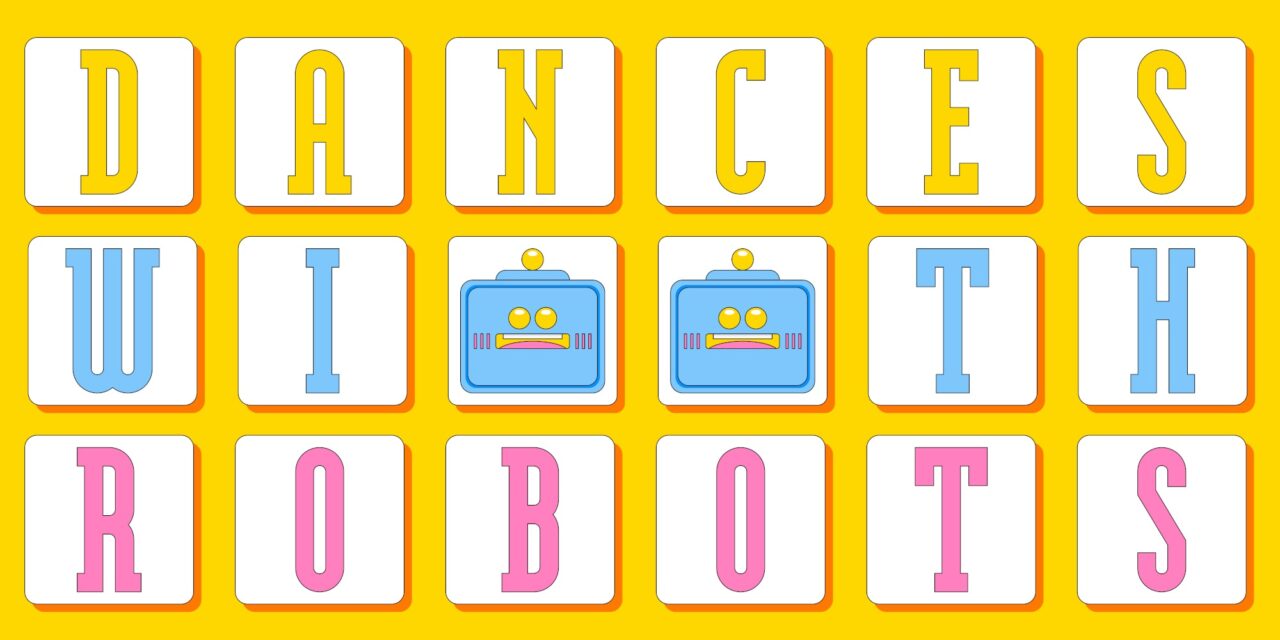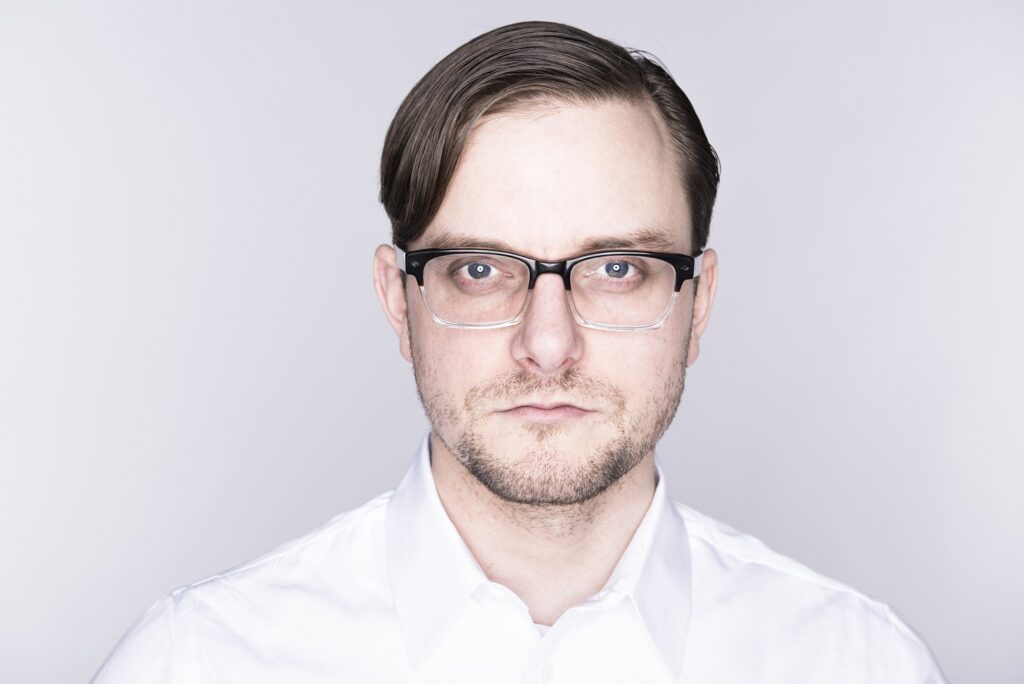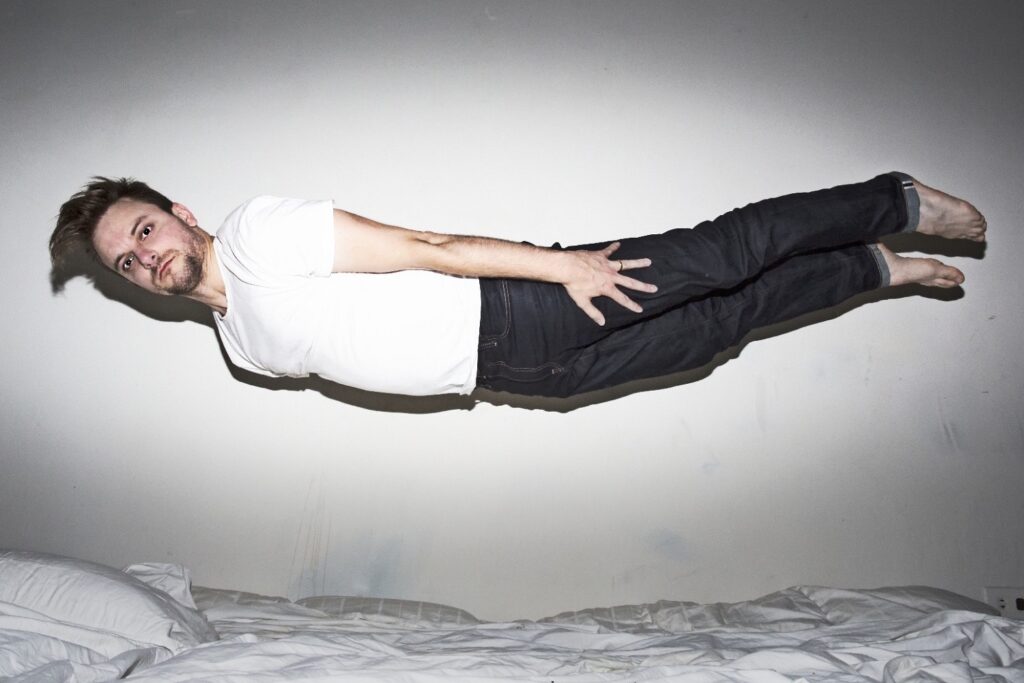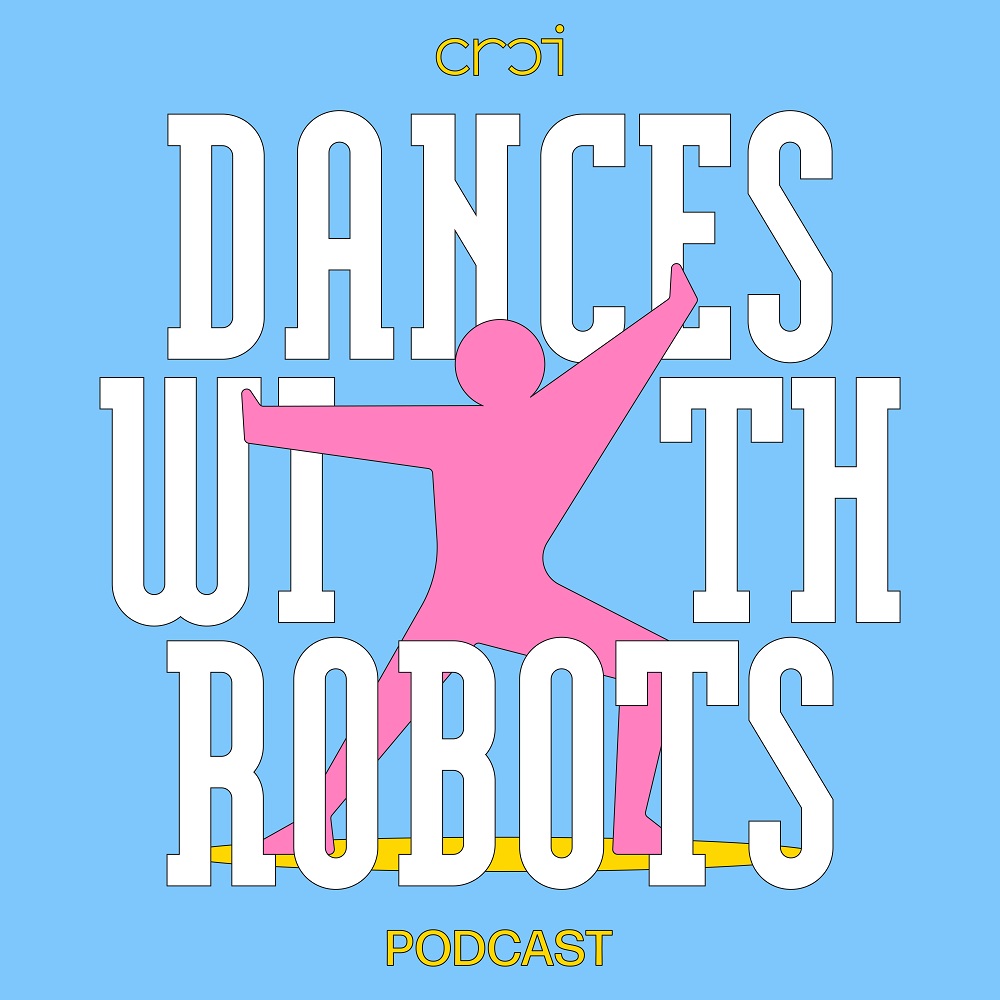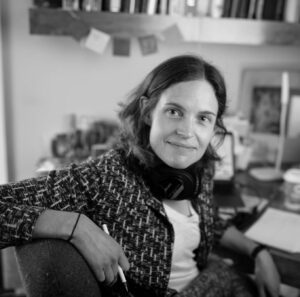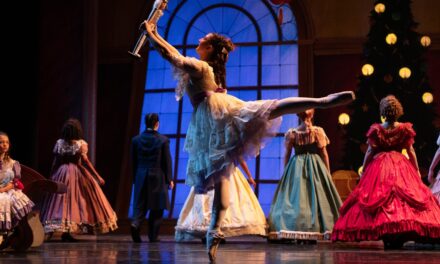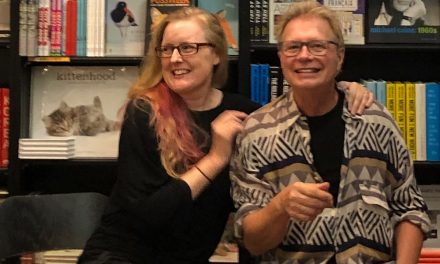Sydney Skybetter is a dancer, choreographer, researcher, and educator whose work has been hailed by the Financial Times as “One of the world’s foremost thinkers on the intersection of dance and emerging technologies.” He is the Deputy Dean of the College for Curriculum and Co-Curriculum at Brown University and recipient of a 2023 Creative Capital “Wild Futures” Award. Skybetter is a Senior Affiliate of metaLAB at Harvard University, a member of Dark Laboratory at Cornell University, and a contributor to WIRED and Dance Magazine. His work has been supported by the Alfred P. Sloan Foundation and the Doris Duke Charitable Foundation. And, as if that were not enough to keep him occupied, Skybetter is the Co-founder and Host of the podcast Dances with Robots presented by The Conference for Research on Choreographic Interfaces (CRCI). Dances with Robots had its debut on Tuesday, November 14, 2023.
In a press release, Dances with Robots is described as “a podcast catalyzed by the corporeal risks and expressive opportunities of contemporary technologies.” Having no background in technology or Artificial Intelligence (AI), I was completely hooked after listening to Episode 1 “The Nerd Gaggle” where Skybetter describes how replacing a smoke detector in his newly bought century old home sparked an interest in how technology affects the human body and vice versa. Episode I also explains how CRCI was created and how it “interfaces and breaks down exactly how, and why, we work in dance and emerging technologies.”
I would like to thank Skybetter for taking time from his very busy schedule to be interviewed by the LA Dance Chronicle. I would also like to take this opportunity to thank Michelle Tabnick (Michelle Tabnick Public Relations) for bringing this subject to my attention and my partner Martin Holman for advising me on what questions to ask.
I was curious how Skybetter became interested in connecting dance with technology. He explained that it was not so much about bringing the two together but “understanding the historical canon where bodies and emerging technologies of all sorts have been coterminous and mutually constituting for centuries,” He answered.
He went on to state that he occasionally teaches Dance History and when he does “it’s as an archipelago of both technological and aesthetic development. Fireproofing curtains, the proscenium stage, and tutus; these are all technologies that were designed and applied in ways that were political and consternating and concerned with bodies in really interesting ways.”
Skybetter hopes to help artists empower themselves and to create the kind of work that they envision and to enter the art form in a manner of their choosing rather than simply reacting to the unpleasant scenes that the world is presenting to them. Making the leap from the proscenium stage to artificial intelligence or the point shoe to virtual reality are all technologies and functions of people making decisions. “And if we understand dance history as a function of these kinds of collaborations, I think there’s actually more agency for the artist. This ultimately is one of the reasons why I do this work; to articulate ways artists can work today,” Skybetter continued.
I wanted to know what advice Skybetter would give to a young dancer or choreographer who was interested in working with technology. Where would they go or who would they talk to in order to acquire what they need?
“That is such a great question and there are no straightforward answers to that,” Skybetter said with a huge smile on his face. He explained that as of now, the majority of companies that are developing technologies like AI and others are owned and operated by transnational corporations like Google and Meta.
“There are consumer-facing applications of these Artificial Intelligences, like ChatGPT,” he said. “The Bill T. Jones/Arnie Zane Dance Company worked with Google on AI text augmentation of the body using POSnet. There are relatively accessible articulations of these technologies that you can access in the browser and not pay that much money to operate.” Skybetter stressed that it was important to note, however, that at that scale, the corporation owns everything. “The artist has no particular agency outside what is afforded to them by the interface a corporation puts on top of the larger computational apparatus.
He noted how this inequality has always been there. Dancers infrequently own their own theaters or companies their own studio space. “There’s always been this need for a kind of synergistic relationship with other people who have certain means of production versus those who have a certain artistic predisposition. This is how it’s been in the western traditions for centuries.” Skybetter said.
“What is new,” he continued, “is that companies like Google are so voracious and can be so extractive of anyone who interfaces with any of their technologies at any time. As an artist, you lose the rights to anything you make on these platforms unless you have really specific carve-outs, which you tend to need high-powered lawyers and corporate structures to negotiate. Otherwise your work could be used in any number of ways at any time with or without your consent or knowledge.”
We talked about how this is similar to what musical artists experience while working with large recording companies or producers, but on a much larger scale that is unprecedented. “It’s like the music industry metastasized into surveillance capitalism.” Skybetter said.

CRCI Dances with Robots – Kate Gow, Archivist, Web Designer, and Cohost – Photo courtesy of the artist.
Skybetter noted that this begs the question, where do artists go to find agency? Where can artists be empowered to make work that they actually can on some level own? He said that the podcast Dances with Robots does not answer these questions and perhaps as of now there is no answer to my question as to where artists go for assistance and actually own the work.
“One of the reasons we started the podcast was it felt like we had to tell the stories of precarity in hushed tones,” Skybetter said. “As a field, I would love for the dance community to engage more transparently with working practices, specifically so as to make them better.”
One of the people I asked Skybetter about was Kamal Sinclair who currently serves as the Senior Director of Digital Innovation at The Music Center in Los Angeles, home to TMC Arts, Center Theatre Group, Los Angeles Master Chorale, LA Opera, and LA Phil. He was not certain if Sinclair works with AI herself but said that she works with a lot of artists who do. “Her role is, among other things, to curate and create an institutional musculature at The Music Center that is capable of engaging artists who work with emerging technologies.” Skybetter explained. “One of the questions that I know that she wrestles with is what does it mean for The Music Center, which as institutionally phenomenal as it is, does not have a whole lot of experience necessarily in AI per se. What does a residency look like for an artist working in AI? Nobody really knows.”
He went on to point out that creating a model for such a residency would be unlike any previous residencies for a dance company or symphony that has been used for decades. Skybetter related it back to his knowledge of dance history.
“This history of the proscenium stage is top of mind here. People argued about the proscenium stage for a hundred years before it was adopted as part of the mainstream aesthetics of Ballet,” he said. “A hundred years of arguing about a single technology. AI, meanwhile, is like hundreds of bundled technologies that can be disaggregated from the rest.”
One example of how the use of technology was incorporated into the dance and theater arena was footlights. Back in the 17th century, footlights were open-flamed oil lamps with floating wicks. There were numerous incidents where the costumes of ballerinas or actors caught on fire, causing great physical harm. The invention of the electric light bulb solved this hazardous problem.
“It’s an inordinately complex moment and folks like Kamal Sinclair are leading these institutions in a vastly distributed, super complicated media technology environment. She is really good at what she does and it takes brains and a no small amount of fortitude.”
We discussed how the COVID pandemic helped accelerate the use of technology in the arts, technologies that had been developing for decades. Everything was shut down for two years and much of the arts went virtual by necessity. Skybetter noted that he became of age as an artist in the immediate aftermath of 9/11 and the formation of his company was during the great recession of 2008.
“So COVID then was a cataclysm on top of all manner of other cataclysms that have been working against theater subscriber bases for decades,” he added. He thinks that COVID is different in relation to audiences returning to the theater in the numbers that were pre-pandemic. “There is, to my knowledge, no evidence that dance audiences specifically are going to return to earlier behaviors. This means that it means to be a dance theater or a dance company, or a dance artist has to potentially be entirely reconstituted.”
Skybetter stated that all be it ambiguous, the pandemic has presented the artist with an opening to reimagine what it means to be a dance artist. “Working towards agency, working towards justice, or working towards health insurance. It’s not like the previous ways of doing this work were great. We can certainly do better.”
I asked Skybetter to talk about his connection or his role in working with metaLAB at Harvard University, a member of Dark Laboratory at Cornell University, and a contributor to WIRED and Dance Magazine. “Ultimately I understand my role as an artist to be a coalitional actor,” He explained. “Ten, fifteen or twenty years ago I would have considered it my job to run a dance company. Today, I understand my job to be entirely in support and in relation to others. That means that I have to pay really close attention to how communities form and act.”
By that Skybetter means that his support to others is directed towards what they want to accomplish, not necessarily what he would have done instead. He explained how the communities surrounding metaLAB and Dark Laboratory “have an intensely plural and extremely heterogeneous understanding of how power works, how art works, how performance and theory work, and how technology functions.” While working with them Skybetter is also learning how these people understand the world and the kinds of opportunities and tribulations they experience.

CRCI Dances with Robots – James Moses, Sound Editing, Mixing, and Design and Audio Consultantphoto – Photo courtesy of the artist.
“These community formations that I’m thinking about here are metaLAB and Dark Laboratory,” he said. They are at Harvard and Cornell, respectively. These are not exactly entities of the people. And yet, as I do within my position at Brown University, these are organizations that attempt to wield what privilege that they have access to.”
Lins Derry, who Skybetter thinks is phenomenal, works with metaLAB. She is an artist and designer working in the areas of human-computer interaction, data visualization, and choreography. Skybetter hopes to interview her for season two of the podcast. You can see the full list of guest speakers on the Dances with Podcast website.
Skybetter is working with an organization researching how bodies relate to certain emerging technologies. He said that it is difficult to express because, unlike ballet terminology, we simply do not have a large vocabulary when it comes to human bodies relating to technology, especially robots. “And we, more to the point, don’t have dancerly words for how robots move,” he added.
He thinks a lot about dance critics like Edwin Denby, John Martin, and Deborah Jowett who were writing about dance in the 1960’s and 1970s (Jowett is still writing). It was the era of John Cage and Merce Cunningham, Paul Taylor, Yvonne Rainer, Trisha Brown, Rudy Perez, Kenneth King, and the group of Judson Church dance artists. It ushered in the music of Terry Riley, Philip Glass, David Tudor, Alvin Lucier and others. Painters like Robert Rauschenberg, Jasper Johns, and Andy Warhol. It was a completely new era of dance, theater and the visual arts.
“These are dance writers, but also theorists,” he said. “who were actively writing at cataclysmic moments in dance history when we didn’t have words. We didn’t have frameworks. We didn’t have an aesthetic frame. I think about Denby constantly. I think about Martin all the time and the flailing in their early reviews. The criticism is urgent. It’s part of a larger knowledge formation that actually helps us understand what it is we’re doing.”
Dance companies that have worked with the intersection of technology and art are Bill T. Jones/Arnie Zane Dance Company who created a work titled “Ghostcatching” that used 3D motion capture. He created a video titled Body, Movement, Language: AI Sketches with Bill T. Jones that worked with Google’s PosNet. Another is Boston Dynamics that hires dancers and choreographers to create different choreorobotic performances. The first statement on their website reads “Discover practical robotics solutions designed to tackle today’s—and tomorrow’s—toughest automation challenges.”
There is a new AI ballet, collaboratively directed and composed by speech artist and musician Harry Yeff (Reeps100), titled Fusion that will be performed by the Leipzig Ballet that you can read about HERE. The choreographer is Mario Schroder; the music score is collaboratively composed and directed by Harry Yeff and Gadi Sassoon with Teddy Riley; and the stage design and costumes are by Paul Zoller.
“Functionally from my perspective,” Skybetter offered, “this is maybe one of the fastest growing marketplaces for dancerly talent. What used to be cordoned off as industrial or commercial dance performances; is now a wide field of corporate actors in emerging technology specifically trying to understand what dancerly intelligence or choreographic expertise has to do with interface design.” Again he mentioned metaLAB as an example.
Skybetter stated that many of the larger technology companies are hiring dancers to help inform their teams to understand what happens when someone has to interface with technology that lives on their body. Sadly, in comparison to what those company’s technologists earn, dancers are once again on the low end of the spectrum. As in the past 100 plus years, dancers are being exploited. Much of the work that Skybetter does with dancers is to support them by instructing on the historical precedence of this past, to assist in formulating a strategy, to offer tactics on how they appear in the room, and negotiating their fee, etc. In essence, to aid them in not once again being exploited.
When asked about his future plans for Dances with Robots, Skybetter said, “I hope to make an argument to a broader public that dancerly experience is consequential. That choreographic knowledge has meaning, that bodies matter. I am not reinventing the wheel.”
“To be clear, this is a perspective that’s informed by decades of black feminist thinking. Much of this work, especially in emerging technologies, has a datafying relationship to bodies that ultimately abstracts away from the fact that we are made of flesh.”
This is why Skybetter used the example of replacing the smoke alarm in Episode I. He used this anecdote to demonstrate when there is a need for a technological solution, human bodies were imperiled. “The stakes for our bodies are not evenly distributed. My hope with this podcast is to support a larger discourse that is centering embodiment at a moment when technology is so pervasive and specifically to center dancers and choreographers in that conversation.”
“You know, the western dance tradition participates in a harder discourse around whose bodies are consequential, whose bodies are gross, or whose bodies are powerful. I want to re-center on this conversation at a moment – to interrupt it. There are lots of ways that we are encouraged to feel without agency. A great, gleaming world is possible if we acquiesce to the technology, if we acquiesce to the technologists. I want to offer them consideration of the body. The ethos of moving fast and breaking things is fine and dandy until the things that we’re breaking are our bodies.”
“My argument is if we take the time to consider bodies and embodiment, to actually engage those of us who have embodied expertise, yes, the design processes will be slower, but this is a good thing,” Skybetter continued. “It means ultimately the technologies will be more equitable, more inclusive, more accessible, and ultimately more meaningful.”

CRCI Dances with Robots – Ariane Michaud, Executive Producer and Cohost – Photo courtesy of the artist.
When asked if there was anything that he would like to talk about that I had not asked, Skybetter said that he wanted to make clear that the podcast is not his only. It is very much a collaborative effort. “There are really specific people who are actually making this work possible. There is our executive producer, CRCI’s executive producer Ariane Michaud, a conservatory-trained dance artist. It is through her voice, scripting, editing and producorial genius that this podcast is a thing,” he said. “Then there is our archivist, Kate Gow, who has been thinking super deeply about what it means to contend with emerging technologies and archiving those experiences. Then there is our Student Associate, Rishika Kartik who is actually working with AI to help with some of our editing and transcription, and so many others”
The rest of Dances with Robots team includes: Megan Hall/Podcasting Consultant; Laurel Lawson/ Accessibility Consultant; Kamala Sankaram/Music Commission; and James Moses/Sound Editing, Mixing, and Design & Audio Consultant.
To learn more about Dances with Robots and to listen to this season’s podcasts, please visit their website. (https://danceswithrobots.org/)
Written by Jeff Slayton for LA Dance Chronicle.
Featured image: CRCI Dances with Robots Banner – Courtesy of the company.

